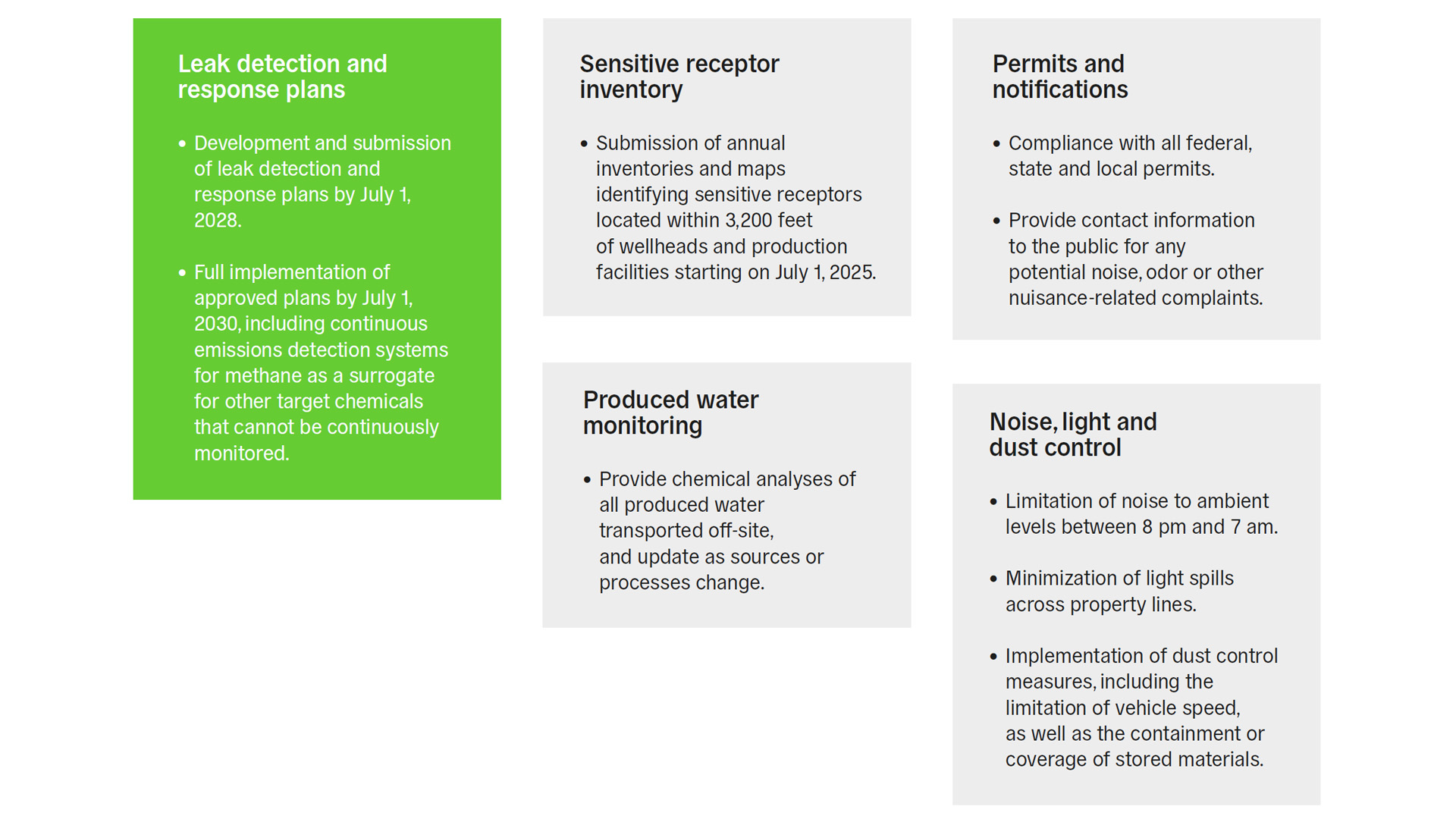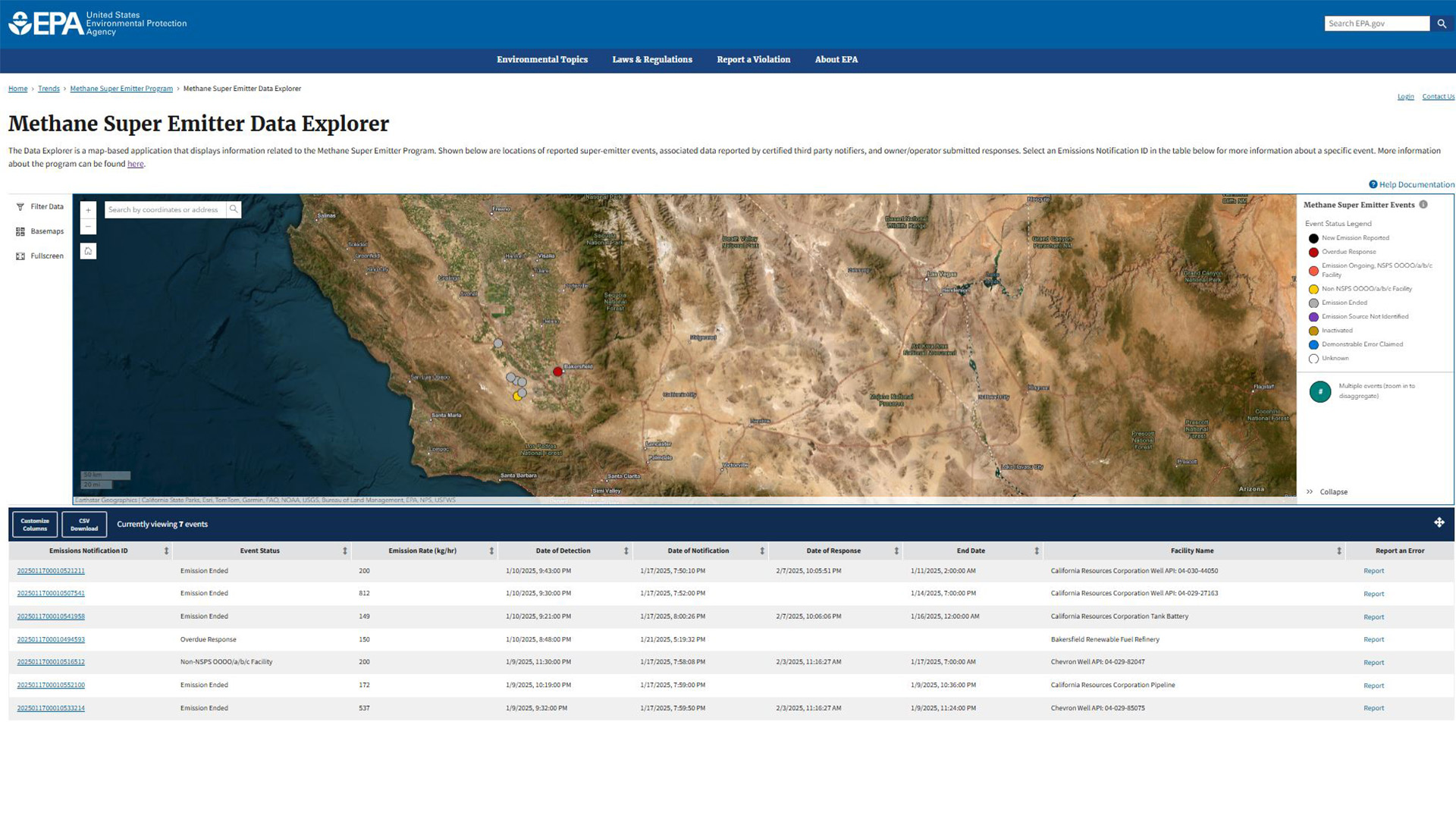09.05.2025
Proactive compliance with California’s Senate Bill 1137
The California Senate Bill 1137 (SB 1137) applies to oil and gas operations located in defined health protection zones within the state. Read on to learn how this bill will affect operations, and how Nubo Sphere can help achieve ompliance—not only with respect to SB 1137 but also California’s developing methane regulations in line with the US EPA’s EG OOOOc.
- Industry Insights
- Oil & Gas

Table of contents
- Future-proof your operations with Nubo Sphere
- Ensure compliance with Senate Bill 1137
- Two (or even three!) birds with one stone: continuous monitoring delivers compliance, insights, and peace of mind
- Compliance with SB 1137: timeline and milestones
- From compliance to leadership: your journey starts now
- Future-proof your operations andinvest in environmental leadership
- Secure SB 1137 compliance today
Future-proof your operations with Nubo Sphere
The California Senate Bill 1137 (SB 1137) applies to oil and gas operations located in defined health protection zones within the state. Read on to learn how this bill will affect operations, and how Nubo Sphere can help achieve compliance—not only with respect to SB 1137 but also California’s developing methane regulations in line with the US EPA’s EG OOOOc.
If you would like to download the article as a printable PDF, please click here: Download
Regulatory compliance—moving forward
SB 1137 requires organizations that operate wells in health protection zones to develop leak detection and monitoring strategies as well as corresponding response plans. The law also requires the California Air Resources Board (CARB) to adopt performance standards for continuous emissions detection systems that issue alerts whenever methane or other chemical leaks occur.
The extent to which CARB’s standard will align with the EPA’s OOOOc emissions guidelines remains to be seen, however there is already one common theme: under EG OOOOc, EPA allows the use of continuous monitoring as an alternative technology. SB 1137 requires it! Clearly, continuous emissions monitoring will play a major role in California in the future. Nubo Sphere, providing continuous monitoring with best-in-class sensor technology and a modular design, meets the requirements of both regulations—today and tomorrow. This is future-proof monitoring all the way through.
California Satellite Partnership—detect emissions first
The state of California has partnered with Carbon Mapper and other providers to use satellite data to pinpoint and identify large, localized sources of methane emissions at leak rates down to 100 kilograms per hour. With the EPA's Super Emitter Program aiming to detect comparable methane emissions sources, there is an opportunity to preempt
all third-party monitoring by using one unique solution: Nubo Sphere. This continuous monitoring solution enables operators to detect potential emissions before they are detected by third parties and made public, thus preventing costly fees and reputational damage.
Ensure compliance with Senate Bill 1137
California’s Senate Bill 1137 imposes strict regulations on oil and gas operations, emphasizing the need for transparency, safety and environmental stewardship. Compliance is no longer optional and becomes critical for
maintaining operations and avoiding potential negative consequences. Starting on July 1, 2026, compliance becomes mandatory with increasingly more stringent monitoring and reporting requirements by 2030.
Which oil and gas operators are affected?
SB 1137 applies to operations that fall within health protection zones—any area within 3,200 feet of a “sensitive receptor”. SB 1137 designates sensitive receptors as follows: residences, educational centers including parks and daycares, community resource centers including youth resource centers, health care facilities, live-in housing including dormitories and prisons, and any buildings housing businesses open to the public. This makes SB 1137 particularly important for operators in the Los Angeles Basin, and in or near other populated areas such as Santa Barbara, Ventura, Santa Clarita, and Santa Maria. Kern County operations near population centers such as Bakersfield or any correctional facilities may also fall within health protection zones.
What does SB 1137 mean for oil and gas operators?
SB 1137 introduces the following requirements for oil and gas operations in health protection zones:

Two (or even three!) birds with one stone: continuous monitoring delivers compliance, insights, and peace of mind
California’s satellite monitoring program—stay ahead of third-party detections
Starting in January 2025, CARB has begun using satellite data to detect super emitter events (> 100 kg/h). By deploying continuous monitoring, operators gain 24/7 insights into their sites’ emissions. This is the key to detecting and remedying large leaks prior to third–party detection and, therefore, a key protection against reputational damage.
Proactive compliance with SB 1137—be prepared to make your choice by 2028
The path to compliance is detailed and time sensitive. Operators must:
- Submit sensitive receptor inventories and maps by July 1, 2025.
- Submit leak detection and response plans no later than July 1, 2028, with approval by CARB in 2029 and full implementation required by July 1, 2030. Otherwise, the operator must suspend all production and injection operations within health protection zones.
Plan submission and its final implementation includes the choice and deployment of a continuous methane emissions monitoring system to ensure early detection of leaks.

Compliance with SB 1137: timeline and milestones
Alignment with EPA’s EG OOOOc requirements and timeline
Starting in 2029, the approved state plans following EPA's OOOOc emissions guidelines will replace existing NSPS OOOOa regulations. OOOOc guides US states in developing and implementing their own regulations to limit emissions from existing sources built, modified, or reconstructed on or before December 6, 2022. These regulations will require more frequent monitoring and thus allow the use of approved continuous monitoring solutions. SB 1137 will move California’s regulations in a similar direction, as it orders the use of continuously operating emissions detection systems for sites in health protection zones. It’s not yet clear if California will require continuous monitoring at all sites, but it is clear that continuous monitoring will satisfy California’s requirements at sites where emissions monitoring is applicable. Continuous methane emissions monitoring will therefore play a crucial role in California's future oil and gas operations.

From compliance to leadership: your journey starts now
SB 1137 was developed to mitigate the local effects of pollution and prevent any resulting conflict between oil and gas operations and surrounding communities. By complying with SB 1137 early, operators can protect their operations against challenges that might arise while SB 1137 is brought into force. The countdown to compliance has begun. SB 1137 mandates leak detection and response plans to be fully implemented by 2030. Waiting until the last minute can lead to unnecessary risks and inefficiencies.
Prevent last-minute scrambles
Implement technology now to stay ahead of deadlines. Seamless integration takes time: testing technologies across different basins and operations, scaling deployments and updating work practices across teams all require planning and time.
Avoid costly fees
Proactive monitoring ensures that you stay ahead of regulatory deadlines and costly fees such as Waste Emission Charges.
Protect your reputation
Prevent super emitter claims: third-party monitors are now detecting super emitter events across the US, with a focus on the State of California due to the CARB satellite program. Find and stop large emissions first to avoid penalties and negative public exposure.
Be an industry leader
Continuous asset monitoring demonstrates your commitment to environmental stewardship and supports operational excellence.
Future-proof your operations andinvest in environmental leadership
Compliance isn’t just a requirement—methane mitigation is an opportunity to improve operational efficiency and sustainability. Put your trust in Nubo Sphere to benefit from the following advantages:
Stay ahead of deadlines
Our future-proof continuous monitoring solution ensures compliance readiness well before 2029, covering SB 1137 as well as EPA’s EG OOOOc requirements.
Proven, best-in-class technology
Nubo Sphere’s innovative photoacoustic-based laser spectroscopy outperforms metal-oxide sensors for accurate and reliable long-term methane emissions monitoring. No in-field calibration is required to account for baseline or sensitivity drift. With the highest specificity to methane, it avoids false positives. Metal-oxide based solutions struggle to provide reliable outputs, especially on sites with high background concentrations due to the site’s topography or emission profile.
Full scalability
High volume production capabilities allow for short lead times while ensuring the highest quality standards.
Fast time-to-detection
Intelligent sensor node placement enables full-site coverage year-round. Thanks to several key sensor features, Nubo Sphere provides more flexibility and longevity.
Multi-gas monitoring
Nubo Sphere’s modular cartridge design offers the ability to upgrade and monitor other gases such as hydrogen sulfide, ensuring adaptability to changing requirements.
Robust design
Rigorously tested under a broad range of environmental conditions, Nubo Sphere is built to work reliably across California’s varying environments and topographies.
Nubo Sphere offers more than compliance with SB 1137. Positioned at the leading edge of advanced technologies for methane emissions monitoring, Nubo Sphere has received EPA approval as a continuous monitoring and periodic monitoring solution for oil and gas sites, supporting operators in compliance with the latest EPA regulations and upcoming state-level regulations.
Secure SB 1137 compliance today
Continuous methane emissions monitoring isn’t just about compliance—it’s a strategic investment in your operation’s future. Don’t wait until deadlines loom. Act now to protect operations, meet future regulatory requirements, and demonstrate your commitment to sustainability. The technology to monitor oil and gas sites for methane leaks is readily available and designed with the future in mind.
Related Insights Blog
19.11.2024
How to use continuous monitoring for periodic screening: why Nubo Sphere is seeking EPA approval as a periodic screening solution
This article explores the advantages of continuous monitoring when used for periodic screenings. It includes guidance on the latest EPA regulations found in NSPS OOOOb and GHGRP Subpart W with an eye to efficiently reducing emissions through periodic screenings. Operators interested in upcoming regulations of sources built, modified, or reconstructed before December 6, 2022, can expect similar standards to those found in NSPS OOOOb, but only after state laws have been created in line with the EP
19.11.2024
Continuous monitoring in light of the EPA’s OOOOb and Subpart W
Continuous methane emissions monitoring with Nubo Sphere equips oil and gas operators with year-round oversight of oil and gas assets, quick detection of fugitive methane emissions and actionable insights in support of LDAR activities. The EPA has introduced standards for using continuous monitoring aimed at reducing emissions without unduly increasing operators’ workloads. This article provides in-depth guidance to working with these regulations, focusing on work practices for continuous monito
15.05.2024
Clearing the air: how continuous monitoring supports compliance with the latest EU methane regulations
In April, the European Parliament reached a preliminary agreement with EU member states on legislation to reduce methane emissions from the energy sector. Find out what you need to know to ensure compliance and maintain operational excellence, especially when using continuous monitoring solutions such as Nubo Sphere.
